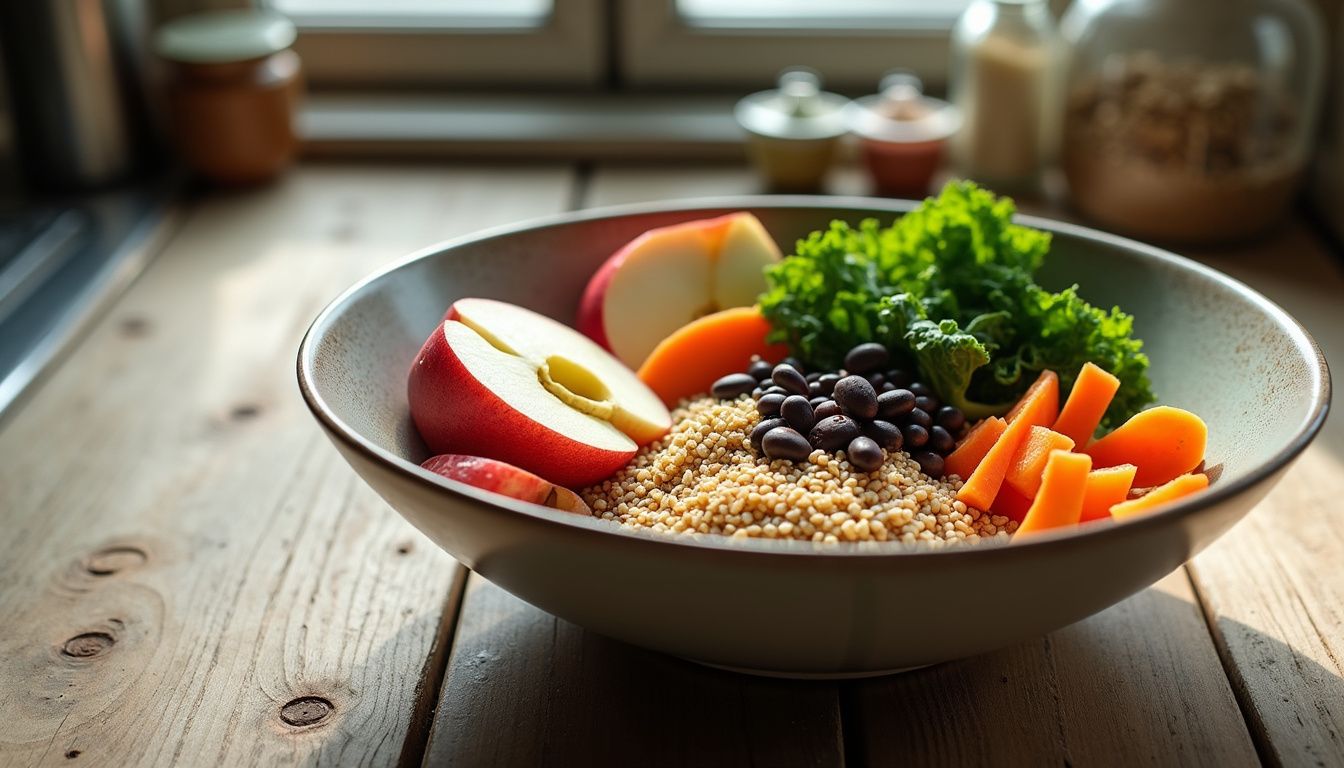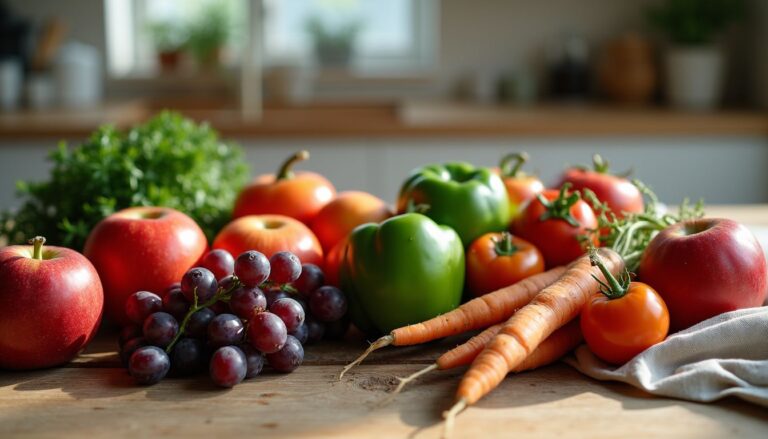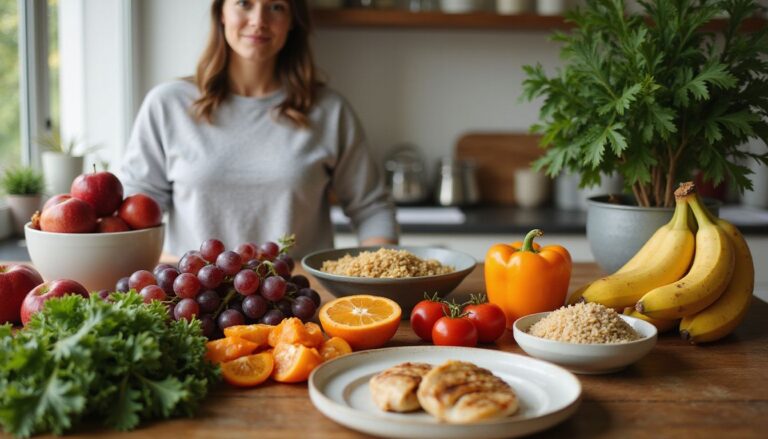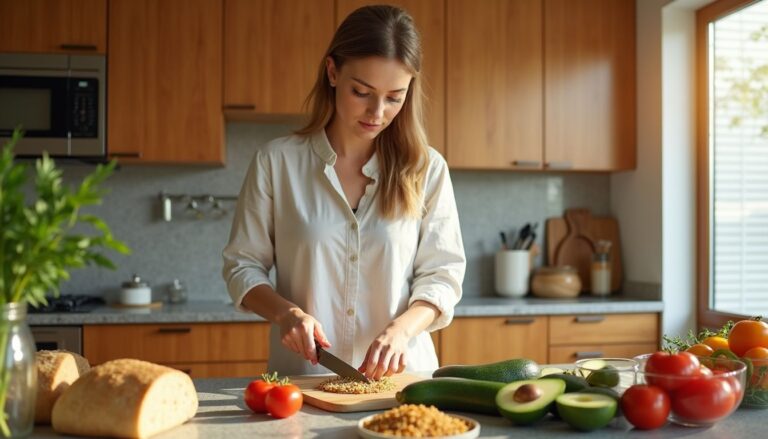Fiber Rich Foods For Weight Loss: Boost Your Health With High-Fiber Options
Our Nutrition Assistant AI Suite will transform your body. You will lose fat, get toned, and build muscle. Gain confidence and optimal health.
You work hard to lose weight, yet hunger and slow progress can drain your energy. Fiber-rich foods make weight loss easier because they keep you full and support healthy digestion.
This guide shows how fruits, vegetables, whole grains, legumes, nuts, and seeds that are high in fiber help with weight management. You will also see which choices fit best for meals and snacks.
Key Takeaways
- Aim for at least 14 grams of fiber per 1,000 calories each day, as advised in the Dietary Guidelines for Americans.
- High-fiber foods like lentils (15.5 g per cup), raspberries (8 g per cup), oats (10.4 g per 100 g), and chickpeas (6.2 g per half cup) help you feel full and may reduce calorie absorption.
- Soluble fiber from oats, beans, and avocados can blunt blood sugar spikes and lower LDL cholesterol, which may reduce heart disease risk by about 10 percent.
- Fiber supports gut bacteria, adds stool bulk, and may lower the risk of constipation, type 2 diabetes, and some cancers.
- Dietitians recommend swapping processed snacks for whole fruits, vegetables, whole grains, legumes, nuts, and seeds to improve health and weight control.
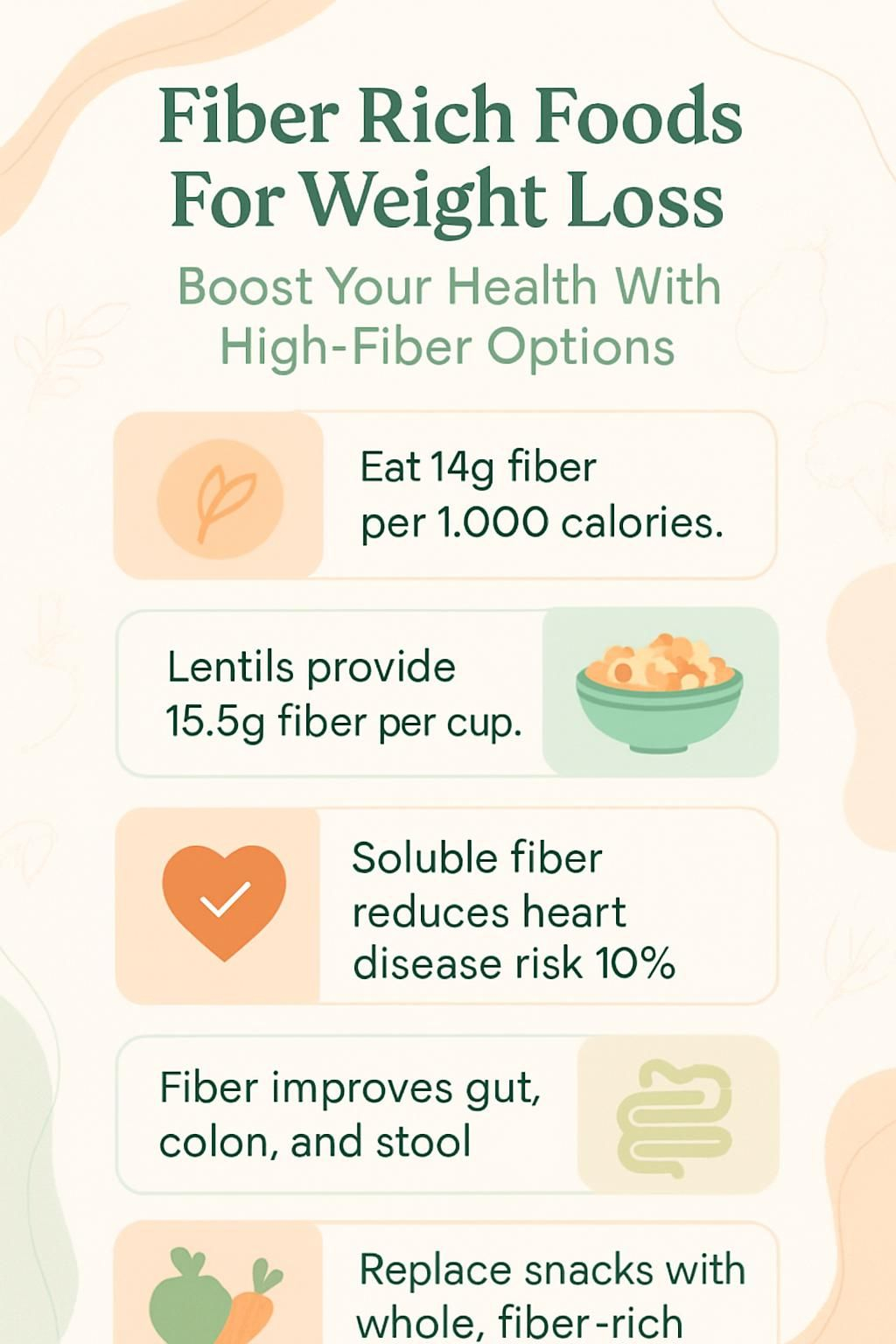
What Are Fiber-Rich Foods?
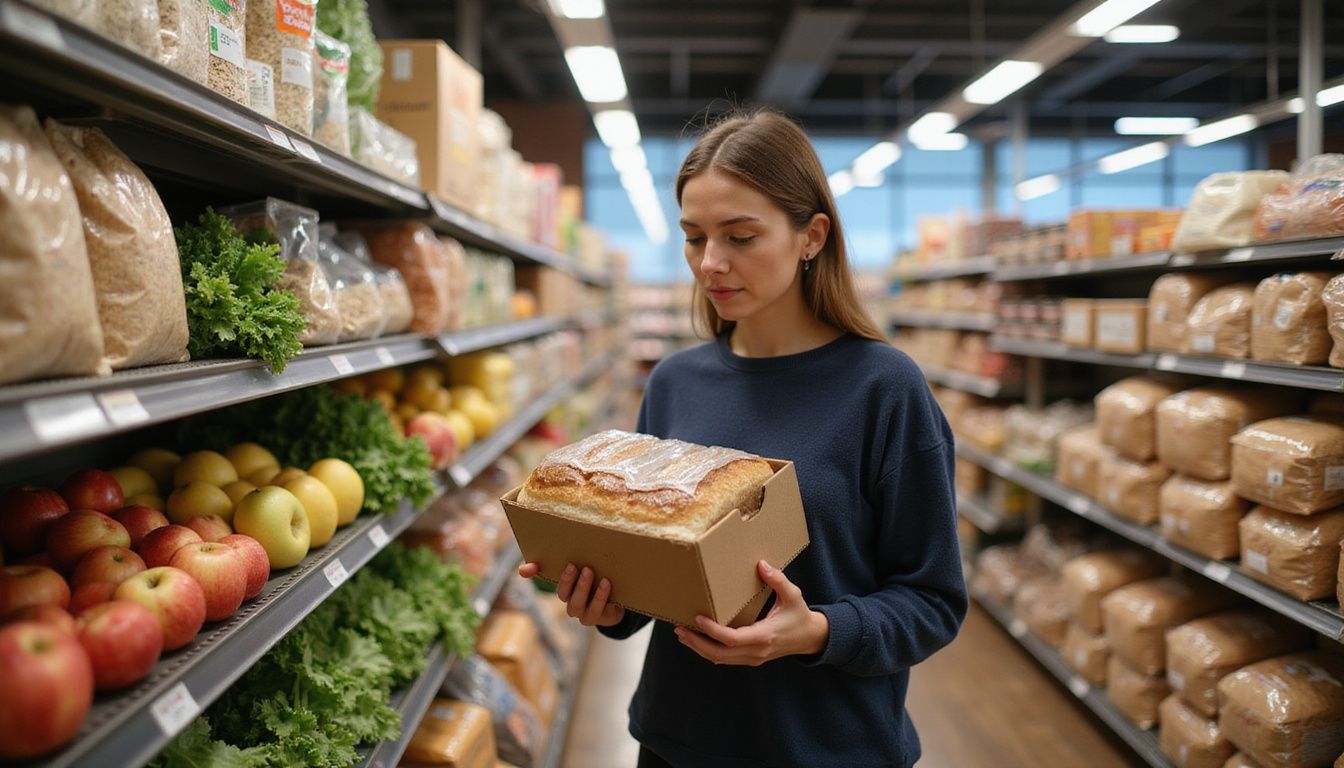
Fiber comes from plants. Animal foods like meat, eggs, and dairy do not contain dietary fiber. Great sources include apples, pears, avocados, broccoli, Brussels sprouts, carrots, artichokes, beets, and sweet potatoes, especially with the skin on.
Whole grains such as oats, quinoa, brown rice, and whole-wheat bread or pasta add steady fiber to your day. Legumes, which are beans and peas, include lentils, chickpeas, black beans, split peas, kidney beans, and pinto beans. They deliver fiber and plant-based protein.
Nuts and seeds help too. Almonds have about 3 grams of fiber per ounce, and chia seeds provide nearly 10 grams per ounce. Check the Nutrition Facts label since processing can change fiber content.
The USDA FoodData Central is a reliable place to verify fiber numbers before you shop. When I traded packaged snacks for whole fruit and oatmeal at breakfast, my digestion improved within weeks and I had less bloating.
For most adults, a helpful target is at least 14 grams of fiber per 1,000 calories. This guidance appears in the Dietary Guidelines for Americans and is supported by professional groups such as the Academy of Nutrition and Dietetics.
Next, see how these high-fiber choices support weight loss through fullness, steady blood sugar, and better digestion.
How Does Fiber Help With Weight Loss?
Fiber-rich foods make weight loss more manageable. They support healthy eating patterns and help you control hunger and calories.
How Does Fiber Promote Fullness and Reduce Hunger?
Soluble and insoluble fiber slow digestion, which helps you feel satisfied after meals. Soluble fiber absorbs water and swells, adding gentle bulk in your gut.
This stretch signals your brain that you have eaten enough. People who reach at least 15 grams of fiber per day from whole foods often report less daylong hunger.
Try oatmeal or yogurt topped with berries and seeds for breakfast to stay satisfied until lunch. Keeping the skin on apples, pears, or potatoes also increases your daily fiber, which can curb overeating later.
Chewing whole produce takes time and energy compared with drinking juice, which may aid calorie control.
Including high-fiber foods such as bean salads can provide about 11 grams of fiber per meal, significantly increasing satiety, says Registered Dietitian Anne Jackson.
Legume-packed salads combine both soluble and insoluble fiber for lasting fullness. Choosing these options makes calorie control feel easier and more natural.
Can Fiber Lower Calorie Absorption?
Yes. Fiber slows the movement of food through your digestive tract. Since fiber is not fully broken down, fewer calories from the meal get absorbed.
Resistant starch is a special kind of carbohydrate that resists digestion. Green bananas are one source. It can reduce calorie uptake even more.
High-fiber foods also require more chewing and take longer to digest. This uses energy and lowers calorie density, bite for bite.
When I shifted to whole grains, beans, and vegetables that are high in protein and fiber, I felt full sooner. Weight loss followed without strict rules.
Drink water throughout the day. Hydration helps fiber move smoothly and do its job. Processed snacks are usually low in fiber and high in easy-to-absorb calories, which can work against weight goals.
How Does Fiber Stabilize Blood Sugar Levels?
Fiber slows how fast carbohydrates enter your bloodstream. This can prevent sharp spikes after meals and may lower the risk of type 2 diabetes.
Soluble fiber, found in oats, beans, apples, and avocados, forms a soft gel in your gut. That gel delays glucose release into the blood.
Oats contain beta glucan, a soluble fiber that helps blunt post-meal blood sugar rises. The Mayo Clinic notes that adding fiber can improve meal glycemic index, a measure of how fast foods raise blood sugar.
Many people notice steadier energy when they include high-fiber foods, with fewer crashes later in the day.
How Does Fiber Improve Digestion and Gut Health?
Fiber adds bulk and holds water, which softens stool and supports regular bowel movements. This helps prevent constipation and keeps your large intestine comfortable.
High-fiber eating patterns also feed good gut bacteria, known as the gut microbiota. These bacteria make short-chain fatty acids, which help keep the colon healthy.
People who eat low-fiber diets often have less diverse gut bacteria and greater risk for chronic conditions. Adding legumes, whole grains, fruits, and vegetables supports a stronger gut community.
Increase fiber slowly and drink enough water to reduce gas and bloating while your body adjusts.
Types of Dietary Fiber
Dietary fiber comes in different forms. Each type acts in a unique way in your body.
What Is Soluble Fiber?
Soluble fiber dissolves in water and forms a gel in your digestive tract. Foods rich in soluble fiber include oats, beans, apples, and avocado.
It slows carbohydrate absorption, which helps control blood sugar after meals. It also binds some cholesterol in the gut and carries it out of the body. Oats are a proven source of beta glucan that supports heart health.
Because digestion slows, you absorb fewer calories and feel full longer. When I added avocado and oatmeal most mornings, I stayed satisfied well into midday.
Soluble fibers also feed helpful gut bacteria. This supports a resilient gut and a strong immune system.
What Is Insoluble Fiber?
Insoluble fiber does not dissolve in water. It passes through your gut mostly unchanged and helps food move along.
Good sources include wheat bran, whole grains, beans like soybeans, vegetables such as carrots and cauliflower, and potatoes with skins. Cooked beets provide about 2 grams of fiber per half cup.
Insoluble fiber adds stool bulk, speeds transit, and helps prevent constipation. It ferments less in the gut than soluble fiber. Many people feel better digestion after a week of adding whole-grain bread and raw vegetables.
Experts in the United States suggest getting fiber from foods first. Whole foods deliver vitamins and minerals alongside fiber, which supports your health more completely than most supplements.
High-Fiber Fruits for Weight Loss
Fruits offer fiber, water, and key vitamins. They make easy snacks that support weight loss.
Which Berries Are High in Fiber?
Berries taste great and pack helpful amounts of fiber. They add color and nutrients to meals and snacks.
- Raspberries provide about 8 grams of fiber per cup, making them one of the highest fiber fruits.
- Strawberries offer around 3 grams per cup, or about 2 grams in a half-cup.
- Blueberries and blackberries also contribute solid fiber, though amounts vary with ripeness and variety.
- Berries add vitamin C, manganese, potassium, folate, and antioxidants that support health.
- Sprinkling berries on breakfast boosts fiber early. I add raspberries to oats for steady fullness.
- Most berries are lower in calories than many other fruits, which helps with calorie control.
- Berries contain both soluble and insoluble fiber to improve digestion and extend fullness.
Mixing berries gives you a wider range of nutrients and a reliable fiber boost.
Are Apples and Pears Good Sources of Fiber?
Apples and pears fit well in a weight-loss plan. Eating the skin adds extra fiber.
- One medium apple with skin has about 4.5 grams of fiber.
- One medium pear delivers around 5.5 grams, while half a large pear offers roughly 2.9 grams.
- Fiber slows digestion, which helps you feel full and may reduce snacking.
- The skin contains much of the fiber, so try to keep it on when possible.
- These fruits are hydrating and relatively low in calories, helpful for managing intake.
- Pack whole fruit for work or school to raise your fiber for the day.
- Adding sliced apple to oatmeal kept me satisfied until lunch and cut morning cravings.
- Pair with yogurt or nuts for balanced snacks and steadier blood sugar.
- Dietitians often recommend apples and pears because they contain both soluble and insoluble fiber.
Choosing these simple fruits makes hitting your daily fiber goal much easier.
Why Include Avocados for Fiber Intake?
Avocados deliver fiber and healthy fats in one creamy package. They are versatile and filling.
- One medium avocado provides about 10 grams of fiber.
- It contains a mix of soluble and insoluble fiber that supports digestion and gut health.
- Healthy fat plus fiber helps you stay full and reduces cravings.
- Avocado fiber can help stabilize blood sugar after meals.
- It supplies vitamins C, E, several B vitamins, potassium, and magnesium for heart health.
- Add slices to salads or sandwiches, or enjoy half as a snack.
- Regular avocado intake is linked with better diet quality and may support heart health.
- Fiber in avocado can support healthy cholesterol levels as part of a balanced diet.
- Try it mashed on toast or blended in smoothies for a quick fiber lift.
- When I added half an avocado to breakfast for a month, I noticed fewer midmorning snacks and steadier energy.
High-Fiber Vegetables for Weight Loss
Vegetables are low in calories and rich in fiber. They help you stay satisfied without adding many calories.
What Are Cruciferous Vegetables and Their Fiber Benefits?
Cruciferous vegetables include broccoli and Brussels sprouts. They offer fiber along with protective plant compounds.
- Boiled broccoli supplies about 5.0 grams of fiber per cup.
- Brussels sprouts provide 4.5 grams per cup boiled, and some cooked portions reach 6.4 grams per cup.
- These vegetables contain antioxidants that support long-term health.
- The mix of soluble and insoluble fiber helps with blood sugar and digestion.
- Enjoy them steamed, roasted, or raw for variety.
- I like roasting broccoli with olive oil until the edges turn crispy. It tastes great and boosts fiber.
- Cruciferous vegetables promote fullness, which can reduce snacking later.
Are Sweet Potatoes and Carrots Good Fiber Sources?
Sweet potatoes and carrots bring fiber, color, and important vitamins to your plate. They are easy to cook and kid friendly.
- One cooked cup of sweet potatoes contains about 6.4 grams of fiber.
- A medium baked potato with skin has about 4.0 grams of fiber.
- One medium raw carrot offers about 1.5 grams of fiber.
- Half a cup of cooked carrots provides about 2.3 grams of fiber.
- Fiber in these vegetables supports fullness and steadier blood sugar.
- Try them baked, boiled, or raw to change up texture and flavor.
- Sweet potatoes also provide vitamin A for vision and immune support.
- Choosing these over refined snacks adds fiber and nutrients to your day.
- High fiber may lower calorie absorption from meals.
- Roast carrot sticks with sweet potato cubes for a simple side that adds taste and nutrition.
How Do Artichokes and Beets Contribute Fiber?
Artichokes and beets make it easier to reach your daily fiber goal. They work well as sides or salad add-ins.
- One cup of cooked artichoke has about 9.6 grams of fiber, placing it among the highest fiber vegetables.
- Artichokes also offer protein, which, paired with fiber, supports fullness.
- Boiling or roasting retains much of their fiber after cooking.
- Cooked beets provide about 2 grams of fiber per 100 grams.
- Beets contain antioxidants and natural nitrates that may support healthy blood pressure.
- Eat beets roasted, boiled, or raw. I prefer them roasted for deeper flavor in salads.
- Both vegetables are easy to add to bowls, salads, or spreads to raise fiber.
High-Fiber Legumes for Weight Loss
Legumes, including beans, peas, and lentils, are budget friendly and packed with fiber and protein. They keep meals filling and balanced, which supports weight loss.
Are Lentils and Split Peas High in Fiber?
Lentils and split peas are reliable fiber stars. They also supply plant protein for steady energy.
- Boiled lentils provide 15.5 grams of fiber per cup.
- Boiled split peas deliver about 16 grams of fiber per cup.
- A half cup of cooked lentils gives about 7.8 grams of fiber and roughly 9 grams of protein.
- A half cup of cooked split peas offers about 8.2 grams of fiber and about 8 grams of protein.
- They shine in soups and dals, adding flavor and comfort to meals.
- High fiber promotes fullness and supports steady blood sugar.
- Sprouting can improve digestibility and add variety.
- These foods provide fiber and plant-based protein that support muscles.
- Whole foods typically work better for digestion than fiber supplements alone.
- Adding lentils or split peas to weekly meals supports fiber goals while keeping calories in check.
Sources:
- United States Department of Agriculture FoodData Central
- Harvard T.H. Chan School of Public Health
How Do Chickpeas and Black Beans Support Fiber Needs?
Chickpeas and black beans are flexible pantry staples. They work in many recipes and raise fiber quickly.
- Cooked chickpeas provide about 6.2 grams of fiber per half cup. Use them in hummus, curries, or soups.
- Boiled black beans give about 15 grams of fiber per cup. Add them to salads, stews, or burritos.
- Both contain a mix of soluble and insoluble fiber for better digestion and hunger control.
- They help stabilize blood sugar after meals and extend fullness.
- Chickpeas and black beans act as prebiotics, feeding friendly gut bacteria.
- They fit vegetarian and vegan meals well because of their protein and fiber.
- Dietitians often suggest including these beans several times per week.
What Fiber Do Kidney and Pinto Beans Provide?
Kidney and pinto beans raise fiber while adding variety to everyday dishes. They are easy to find and budget friendly.
- Cooked kidney beans supply about 5.7 grams of fiber per half cup.
- One cup of canned beans, including kidney or pinto, provides roughly 13 grams of fiber.
- Pinto beans offer similar fiber to kidney beans and work well in chili or stews.
- Both types support steady energy and digestive health.
- Affordable and accessible, they help you hit fiber goals without overspending.
- Using these beans often helped me control my appetite during busy days.
- Adding them to recipes makes meeting daily fiber needs simple.
Whole Grains Packed with Fiber
Whole grains keep the bran and germ, which hold most of the fiber and nutrients. They support weight management and overall health.
Why Choose Oats and Quinoa for Fiber?
Oats and quinoa are versatile and satisfying. They deliver fiber along with important minerals and plant compounds.
- Rolled oats offer about 10.4 grams of fiber per 100 grams.
- Cooked quinoa provides about 8 grams of fiber per cup and is gluten free.
- Both support blood sugar control thanks to slow-digesting carbohydrates.
- Oats are rich in beta glucan, which can lower cholesterol.
- Quinoa supplies magnesium, folate, vitamin B1, and phosphorus for energy and nerve function.
- One medium oat bran muffin, about 113 grams, delivers roughly 5 grams of fiber.
- Add oats to breakfast bowls or bake them into snacks. Use quinoa in salads or as a savory side.
- Fiber in both grains promotes fullness and reduces hunger.
- Because they are naturally gluten free, they suit many people who avoid wheat.
- Regular use supports digestion, cholesterol management, and healthy body weight.
Is Brown Rice a Good Fiber Source?
Brown rice contains the bran and germ, which gives it more fiber than white rice. It is steady, simple, and pairs with many meals.
- One cup of cooked brown rice has about 3.5 grams of fiber.
- Keeping the bran layer raises fiber and nutrients compared with white rice.
- Fiber in brown rice supports regularity and satiety.
- Many people find brown rice provides steadier energy due to slower absorption.
- Use it in stir-fries, grain bowls, and salads.
- Choosing brown rice helps you reach daily fiber targets.
- It can support digestion and weight control as part of a balanced diet.
How Does Air-Popped Popcorn Add Fiber?
Air-popped popcorn is a whole grain snack that feels generous yet light. It can replace chips while raising fiber.
- Three cups, about 24 grams, provide roughly 3.5 to 5.8 grams of fiber.
- It offers both soluble and insoluble fiber to support digestion and gut health.
- Skip heavy butter and sugar. Use herbs or spices like chili powder or cinnamon.
- Choosing popcorn over fried snacks improves your fiber-to-calorie ratio.
- It fits most meal plans and supports weight management.
- When I switched to air-popped popcorn, I stayed full longer between meals.
- It is a simple way to enjoy a crunchy, higher fiber snack.
Up next, see how nuts and seeds add more fiber to round out your day.
Nuts and Seeds for Adding Fiber
Nuts and seeds raise fiber while adding healthy fats and crunch. Small amounts go a long way.
What Fiber Benefits Do Chia Seeds and Flaxseeds Offer?
Chia seeds and flaxseeds are fiber powerhouses. They are easy to sprinkle on many foods.
- Chia seeds provide about 10 grams of fiber per 1 ounce serving.
- One tablespoon of chia gives about 4.1 grams of fiber.
- Flaxseeds supply both soluble and insoluble fiber plus omega-3 fats for heart health.
- These seeds absorb water in the stomach, which increases fullness and tames cravings.
- Sprinkle on yogurt, oatmeal, or salads to raise fiber without much effort.
- Use chia in jams, bars, and smoothies for texture and nutrition.
- Both can help stabilize blood sugar by slowing carbohydrate absorption.
- Soluble fiber in these seeds may lower cholesterol levels.
- I add chia to my oatmeal for longer fullness and fewer snacks.
Next, consider almonds and walnuts for a fiber boost with satisfying crunch.
Are Almonds and Walnuts Good for Fiber?
Almonds and walnuts raise fiber, add healthy fats, and taste great. They work well as snacks or toppings.
- Almonds offer about 3.5 grams of fiber per 1 ounce, or about 23 nuts.
- Almond flour can raise fiber in baked goods, including gluten-free recipes.
- Walnuts support digestive health with their fiber and are easy to add to cereals or salads.
- Pistachios contain about 3 grams of fiber per 1 ounce, around 49 nuts, and make a tasty option.
- Sunflower kernels provide about 3 grams of fiber in one quarter cup.
- Regular nut intake supports heart and digestive health thanks to fiber, vitamins, and minerals.
Using a small handful of nuts each day can move your fiber intake closer to your goal.
Benefits of High-Fiber Foods Beyond Weight Loss
Fiber supports many parts of your health, from your heart to your gut. It helps your body run smoothly and predictably.
How Does Fiber Reduce the Risk of Heart Disease?
Eating more fiber can improve several heart risk factors. Soluble fiber, found in oats and beans, reduces how much cholesterol you absorb.
Oats contain beta glucan, a soluble fiber that can reduce LDL cholesterol by up to 10 percent when eaten daily. Avocados offer fiber and healthy fats that support blood pressure and heart function.
Whole grains like barley and bran-rich cereals are linked with better cholesterol and fewer cardiovascular events over time.
In What Ways Does Fiber Support Colon Health?
Fiber increases stool bulk and softness, making bowel movements easier. This can reduce strain and help prevent constipation.
Fermentable fibers feed helpful gut bacteria. These bacteria produce short-chain fatty acids that support the colon lining. Populations with higher fiber intake show lower rates of some colon problems.
Raise fiber slowly to limit gas while your gut adjusts. A healthy gut is tied to strong digestion and a resilient immune system.
How Can Fiber Improve Cholesterol Levels?
Soluble fiber from oats, beans, and apples helps lower cholesterol absorption in the intestine. An oat bran muffin at breakfast adds about 5 grams of fiber and can support healthy cholesterol numbers.
Whole grains such as bran flakes and barley also improve lipid profiles. Many people find that starting the day with oatmeal is an easy way to support healthy cholesterol throughout the year.
Tips for Incorporating More Fiber into Your Diet
Small changes add up. These simple steps help you meet daily fiber needs without overhauling your entire routine.
How Can You Start Your Day With Fiber-Rich Breakfasts?
Breakfast sets the tone for steady energy. Choose options that stack up fiber early.
- Use oatmeal as a base. One cup cooked has about 4 grams of fiber.
- Add raspberries. One cup provides about 8 grams of fiber.
- Combine oatmeal, raspberries, and half a serving of almonds to reach about 13.5 grams.
- Pick bran flakes if you prefer cereal. Three fourths of a cup offers around 5.5 grams.
- Stir a tablespoon of chia seeds into yogurt or smoothies for 4.1 grams more.
- Whole grain rolled oats provide about 10.4 grams of fiber per 100 grams dry.
- Try warm quinoa. One cup cooked gives about 8 grams of fiber.
- Use almond flour in pancakes or muffins to increase fiber.
- Top with strawberries or mixed berries for extra flavor and fiber.
Switching from white toast to oatmeal with berries can keep you satisfied until midday and limit cravings.
What Are Easy Ways to Add Legumes and Vegetables to Meals?
Legumes and vegetables raise fiber without much effort. These ideas fit most weekly meal plans.
- Make a bean and vegetable salad. One serving can provide about 11 grams of fiber.
- Add lentils, split peas, or chickpeas to soups and stews. A half cup gives 6 to 8 grams.
- Mix black beans into salads or burritos. One cup provides about 15 grams of fiber.
- Stir green peas into rice or pasta. One cup boiled gives about 9 grams.
- Bake or mash sweet potatoes. One cooked cup delivers about 6.4 grams.
- Include broccoli or Brussels sprouts with dinner. One cup offers up to 5 grams.
- Top bowls with roasted artichoke hearts. One cup adds nearly 10 grams.
- Snack on raw carrots. One medium carrot adds about 1.5 grams.
These steps improve nutrition, flavor, and fullness in one move.
Why Choose Whole-Grain Options Over Refined Grains?
Whole grains keep more of their natural parts, which means more fiber and nutrients. Refined grains lose these parts during processing.
- Whole grains include the bran and germ, the richest fiber layers.
- One cup of whole-wheat spaghetti provides about 6.0 grams of fiber.
- Quinoa gives about 8 grams of fiber per cooked cup.
- Brown rice delivers about 3.5 grams per cup and keeps you full longer than white rice.
- Bran flakes contain about 5.5 grams of fiber in three fourths of a cup.
- Air-popped popcorn offers about 3.5 grams of fiber in three cups.
- One cooked cup of instant oatmeal gives about 4.0 grams of fiber.
- Choosing whole grains at each meal raises total daily fiber and nutrient intake.
- My switch from white bread to whole-wheat improved digestion and satiety during the day.
What Are Healthy Fiber-Rich Snacks?
Smart snacks prevent energy dips and overeating later. These options travel well and come together fast.
- Choose an apple or pear. Each provides more than 4 grams of fiber.
- Eat one cup of raspberries for about 8 grams of fiber.
- Enjoy air-popped popcorn without butter, about 3.5 grams per three cups.
- Snack on green peas or broccoli florets for at least 3 grams per serving.
- Pair hummus with carrot sticks for soluble fiber plus crunch.
- Grab a handful of almonds. One ounce provides close to 3.5 grams.
- Make chia pudding with milk of choice. Two tablespoons supply almost 10 grams.
- Roast chickpeas. A half cup provides about 6 grams.
- Spread mashed avocado on whole-grain toast. One avocado contains nearly 10 grams.
- Blend flaxseeds into yogurt or smoothies. Two tablespoons provide around 4 grams.
Keeping several options on hand makes it easy to hit your daily target.
Common Questions About Fiber and Weight Loss
It is normal to have questions as you raise fiber intake. Clear answers help you build habits that last.
How Much Fiber Should You Eat Daily?
If you are age two or older, aim for 14 grams of fiber for every 1,000 calories you eat. Children 12 to 23 months need about 19 grams per day.
Many adults benefit from 35 to 50 grams per day, though most Americans get only 10 to 15 grams. Increase fiber gradually to limit discomfort.
When I added beans and vegetables over several weeks instead of all at once, my digestion improved without gas or cramps. If you have a digestive condition, ask a healthcare professional for personalized advice.
Can Eating Too Much Fiber Cause Side Effects?
Yes. Jumping from low to high fiber quickly can lead to gas, diarrhea, cramping, or bloating. Your gut needs time to adapt.
Raise fiber in small steps and drink plenty of water. Fluids help fiber move through the digestive tract and prevent hard stools.
If symptoms persist, consult a registered dietitian or your clinician for tailored guidance.
What’s the Difference Between Soluble and Insoluble Fiber?
Soluble fiber dissolves in water and forms a gel. It slows digestion, supports fullness, and helps manage blood sugar. Oats, apples, carrots, and beans are good sources.
Insoluble fiber does not dissolve in water. It speeds movement through the large intestine and helps prevent constipation. Whole-wheat bread, brown rice, nuts, cauliflower, and green beans supply this type.
Both are important. I often pair oatmeal with berries for soluble fiber, plus whole-grain toast for more insoluble fiber and better balance.
Conclusion
Choosing fiber-rich foods each day helps with weight management and long-term health. Fill your plate with high-fiber fruits, vegetables, whole grains, legumes, nuts, and seeds.
These foods help you feel full longer, support digestion, and steady blood sugar. Start with small steps, such as adding beans to salads or swapping white bread for whole grain.
Check food labels and aim for at least 14 grams of fiber per 1,000 calories, as recommended in the U.S. Dietary Guidelines. If you have medical concerns, seek advice from a qualified professional. Small changes, done daily, can build comfort, confidence, and lasting results.
FAQs
1. What are fiber-rich foods, and how do they help with weight loss?
Fiber-rich foods include beans, lentils, whole grains such as oats or barley, vegetables like broccoli or carrots, and fruits including apples or pears. These foods slow digestion and increase feelings of fullness. Research from the Harvard T.H. Chan School of Public Health shows that people who eat more dietary fiber tend to weigh less over time.
2. How much fiber should I eat daily for effective weight management?
The Dietary Guidelines for Americans recommend about 25 grams per day for women and 38 grams per day for men under age 50; older adults need slightly less. Eating enough fiber supports healthy digestion and helps control appetite according to studies published in Nutrition Reviews.
3. Can high-fiber options improve overall health beyond supporting weight loss?
Yes; a diet rich in plant-based fibers can lower cholesterol levels, stabilize blood sugar, and reduce risk factors linked to heart disease based on data from the American Heart Association.
4. What is an easy way to add more high-fiber choices into my meals?
Start by replacing white bread with rye bread or brown rice instead of refined grains at lunch or dinner. Add chickpeas to salads or snack on berries between meals; these simple swaps raise your daily intake without major changes to your routine.
Summary: Fiber-rich food sources such as legumes, whole grains like millet or quinoa, vegetables including spinach or squash, and fruits provide lasting satiety while aiding weight management efforts according to credible research findings.

